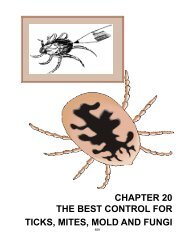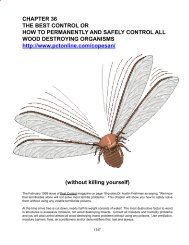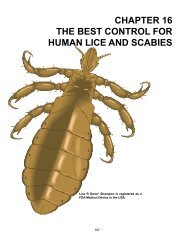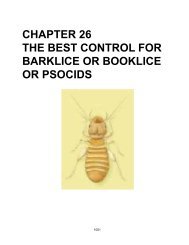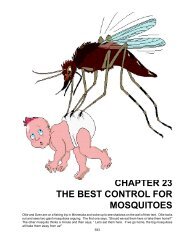Menthol - can be used to kill mites and/or repel ticks. Put a line of Vapo Rub ® where you do not want mites orticks to cross. Renew as needed.Mescal or coral bean (Sophora secundiflora) - Powdered seeds of this flowering shrub are toxic to armywormsand other insects.Metal Nit or Flea Combs - and a little patience and baby oil or soapy water will safely control lice and/or fleas.Methyl Carbitol - Make a wax or paraffin slurry with 5% - 10% methyl carbitol to repel imported fire ants, otherinsects and vertebrate pests.Methylene Blue - C 16H 18CIN 3S.3H 2O used as a dye, as a bacteriological and biological stain will sterilize termites(and other insects) that eat it.Microbial Pesticides - are alternative control products whose active ingredient is a living organism, bacteria,viruses, fungi and nematodes; some 1500 such agents have been found, e.g.: Agrobacterium radiobacter -This bacterium is used to prevent the development of bacterial crown gall (Agrobacterium tummefasciens).<strong>The</strong> “good” microbe colonizes roots and steps, supposedly preventing infection for 1 - 2 seasons. Bacilluspopillae - (better known as milky spore) is a popular agent used against the larvae of Japanese beetle. Bacillussphaericus - is a microbe used for mosquito control in dirty water habitats. Bascillus subtilis - is used as a seedinoculant to prevent damping-off in cotton, peanuts and beans. Bacillus thuringiensis - is probably the oldestand best known of biological pesticides. <strong>The</strong>re are many strains of this bacterium. Beauvaria bassiant - Thisfungus is used to control aphids, leafhoppers, thrips, whiteflies and mealybugs. Collectotrichum gloeosporioidesspp. aeshynomene - This specie of anthracnose is used to control northern jointvetch. Collectotrichum gloeosporioidesspp. malvae - is used to control mallow in various field crops. Entomophaga maimaiga - This Asianfungus is used to control gypsy moth populations. Nuclear Polyhedrosis Viruses - This series of viruses is usedto control many types of caterpillars. Phytophthora palmivora - This water mold is used to control strangler vinein Florida’s citrus groves. Puccinia cannliculata - This rust species is used to control yellow nutsedge. Streptomycesgriseoviridis - This microbe, discovered in Finnish peat bogs, is used as a fungicide and try to preventseveral root diseases. Trichoderma harzianum - In the soil it colonizes roots and is used to control Pythium andPhytophthora rot. Verticillium lecanii - can be used to control aphids and whitefly.MICROBIAL INSECTICIDES Bacillus thuringensis, (Dipel, Thuricide, Attack, Catapiller Killer), M-OneAdvantages: Selective; non-toxic to wildlife and humans; may establish and provide control in the future.Disadvantages: <strong>Control</strong>s only one certain species or group of insects; broken down by the elements sotiming is critical; special storage or application procedures may be necessary.See Enzyme Cleaners.Microbial Plant Inoculants - including rhizobia bacteria, Mycorhizzae azolla, Axotobacter, etc. Make sure theydo not contain any prohibited substances.Microbes - Safe Solutions, Inc. microbes (liquid/freeze-dried) can be extremely helpful in controlling pest problems,removing muck and odors, but be careful when you mix them as they are easily killed by chlorine, flouideand other disinfectants.Microwave - Nuke ‘em. While this may seem very satisfying to us humans and is environmentally sound, themethod is not recommended. <strong>The</strong> reasons are as follows: <strong>The</strong> microwaves heat up the infested material andthe subsequent heat could damage the object. To kill an insect, there must be at least 75% relative humidity inthe oven. To increase the humidity to such a level would also risk severe damage to the infested article. Youcan sterilize fully soaked rags and sponges in a microwave for 2 minutes, but some sponges can burst intoflames. See Clothes Dryer.Milk - If you spray fresh milk twice a week, diluted one part milk to nine parts of water, it will stop powdery mildew,e.g., Sphaerotheca fuliginea, faster and better than “registered” fungicide poisons. Milk can also be usedto control various mosaic viruses, a broad spectrum of bacteria and fungi.Milk Jugs - <strong>The</strong> top half of a plastic milk jug makes a funnel or a scoop or use the top half as a mini-greenhouse;the cap can be removed to make a vent.414
Milk Thistle - is a proven detoxifier that guards against the deterioration of the liver and should be the first thingyou take if you are diagnosed with hepatitis C. <strong>The</strong> health benefits of Milk Thistle seed (Silybum marianum) havebeen known for more than 2,000 years. Milk Thistle is a herbaceous plant with a dense-prickly flower head andreddish-purple tubular flowers. It is native to the Mediterranean area and is now grown in Central Europe, Northand South America, and Southern Australia. Milk Thistle a/k/a Marian Thistle, Mary Thistle, and Lady’s Thistle,is a member of the Asteacea family. Historically, milk thistle was used for relieving congestion of the liver, kidneysand spleen and by lactating women to stimulate the production of milk. Currently, standardized milk thistleseed extract is used to maintain and regain liver health, especially those who consume excessive amounts ofalcohol. This use was validated by studies using between 200 mg and 420 mg of silymarin per day (usually inthree separate doses). Milk Thistle has an extensive history of use as an edible plant. In the 1st century AD,Pliny the Elder reported its use for supporting liver health. <strong>The</strong>ophrastus (IV century BC) and Dioscorides (1stcentury AD) also wrote of its value. <strong>The</strong> English herbalist, Nicholas Culpeper (1650) claimed it was effective forsupporting the normal functioning of the liver.Research suggests that this herb is beneficial in protecting, detoxifying and strengthening the liver. Certaindiseases that occur in the liver may also benefit from milk thistle seed. Those suffering from hepatitis and livercirrhosis may benefit from this herb. It also shows promise in improving overall liver function. Many clinical studieshave demonstrated that this herb supports healthy liver function and provides powerful antioxidant protection,particularly from free radicals and other toxins that normally enter into the liver and cause damage. A primaryconstituent of silymarin called silibinin also helps to support healthy liver function, encouraging healthy cholesterolsynthesis by the liver. In addition to its well-recognized role in promoting liver health, key constituents inmilk thistle also help to maintain normal kidney function and promote optimal immune function. Limited researchsuggests that this herb may also support healthy prostate function, and encourage a vital gastrointestinal tractby protecting it from free radical damage.Those who suffer from acne may benefit from milk thistle seed. <strong>The</strong> high level of antioxidants in this herb aregood for the entire cardiovascular system. However, research suggests that milk thistle seed may help to controlcholesterol issues. It may help to lower bad cholesterol and increase good cholesterol. Resarch suggests that thisherb may help to control a person’s diabetes. It shows the most promise in those who are not insulin dependent.This herb is said to possess the most benefits for diabetes when combined with a healthy diet and exercise.Milk Thistle seed is said to possess many benefits for digestive system. It is said to help soothe some of thesymptoms associated with irritable bowel syndrome and Crohn’s disease. It may also be beneficial in treatingand preventing gallstones. Milk thistle seed is also said to be a power anti-inflammatory so it is said to be quitebeneficial to those suffering from intestinal inflammations. Milk thistle is also said to be beneficial to thosesuffering from certain types of cancer. It is also said to help the liver function “normally” when it is stressed outfrom medical treatments such as powerful drugs, chemotherapy and radiation. Milk thistle seed is an importantnatural treatment for COPD, or Chronic obstructive pulmonary disease. It counteracts much of the stress that’splaced on the liver as a result of the disorder, and is generally considered safe when used properly.How to use:Grind whole milk thistle seeds in a coffee grinder or spice mill. Add the freshly ground seeds to hot cereal,muffins, rice, or other grains. This is an easy way to consume milk thistle seed and can be supplemented withother milk thistle seed formulations.Caution:If you are considering adding this herb to your diet, you should consult a physician first. Some herbs will interactwith certain medications and medical conditions and this could be dangerous. Milk thistle may occasionally causea mild, transient laxative effect, which normally passes within 3 days of use.Milky Spore Disease - will control Japanese beetles.Milorganite - Composted Milwaukee sewage; the Author will not use nor recommend this product.415
- Page 1:
CHAPTER 11SAFE AND FAR MOREEFFECTIV
- Page 4 and 5:
pesticide poisons do - to them the
- Page 6 and 7:
American Beautyberry (Callicarpa am
- Page 8 and 9:
packets in 4 days or less. Aspartam
- Page 10 and 11:
Baking Soda - Baking soda or sodium
- Page 13 and 14: Bioderivatives - are substances whi
- Page 15 and 16: Bird feeders - will attract more th
- Page 17 and 18: an abrasive action on the insect wh
- Page 19 and 20: pathogens - volatiles produced duri
- Page 21 and 22: ground, grain and stored product ap
- Page 23 and 24: epels many insects, including flies
- Page 25 and 26: een used medically since at least t
- Page 27 and 28: Collateral Damage - When you spray
- Page 29 and 30: Cottonseed Meal - is a source of ni
- Page 31 and 32: Desiccants - Hot air, dehumidifiers
- Page 33 and 34: Dogs - have been trained to sniff o
- Page 35 and 36: elderberry leaves to protect them f
- Page 37 and 38: controls pests and acts as a deodor
- Page 39 and 40: contamination that no one can hones
- Page 41 and 42: Chlorphyll Graphite Parrafin wax Wa
- Page 43 and 44: Film Capsule - The plastic capsule
- Page 45 and 46: Repel roaches with bay leaves and e
- Page 47 and 48: person in your house, but you’ll
- Page 49 and 50: slender sickle-shaped jaws. They ap
- Page 51 and 52: epellent that contains only natural
- Page 53 and 54: infusion of pignut leaves, rubbed o
- Page 55 and 56: Human Hair - cut in small pieces wi
- Page 57 and 58: Insect Diseases - In 1836, Agostino
- Page 59 and 60: Irrigation Management - Improper ir
- Page 61 and 62: lack cutworms.Laxatives - Chocolate
- Page 63: we die. Check out magnesium in Chap
- Page 67 and 68: Moon Flower (Datura ioxia) - Do not
- Page 69 and 70: Spotted knapweed begins producing c
- Page 71 and 72: Nothing - Doing nothing is a choice
- Page 73 and 74: fertilizers and sprays will normall
- Page 75 and 76: added to enzyme cleaners or when us
- Page 77 and 78: yellow to yellow crystalline solid
- Page 79 and 80: Aureolaria virginica (L.) Pennell.
- Page 81 and 82: Clematis vitalba L. (Honduras fish
- Page 83 and 84: Euphorbia bicolor Engelm. and Gray.
- Page 85 and 86: Justicia adhatoda L. (Adhatoda vasi
- Page 87 and 88: Momordica charantis L. (Balsam-pear
- Page 89 and 90: Piper nigrum L. (Black pepper).Stro
- Page 91 and 92: Sesamum indicum L. (S. orientale L.
- Page 93 and 94: Xanthorrhoea hastilis R. Br. (Black
- Page 95 and 96: Pomander - Repel moths and other in
- Page 97 and 98: y Safe Solutions at 1-888-443-8738
- Page 99 and 100: ight red and cover them with petrol
- Page 101 and 102: a wide variety of antioxidants call
- Page 103 and 104: Sawdust - Sawdust can be treated wi
- Page 105 and 106: lit charcoal in the tunnels would a
- Page 107 and 108: Active IngredientGeneric Name Trade
- Page 109 and 110: Sour Milk - sprays will loosen scal
- Page 111 and 112: Stay Calm - Take a deep breath amd
- Page 113 and 114: to make the mix about the consisten
- Page 115 and 116:
pesticides have never controlled or
- Page 117:
Temperature - Increase or lower tem
- Page 120 and 121:
in colder climates. The most fragra
- Page 122 and 123:
and/or dehumidifiers, plumbing and
- Page 124 and 125:
odents, scorpions, etc. to your bai
- Page 126 and 127:
Oregano also contains four anti-ast
- Page 128 and 129:
like colds, and headaches and spend
- Page 130 and 131:
then estimated human population. Gi
- Page 132 and 133:
“The choice, after all, is ours t
- Page 134:
484



